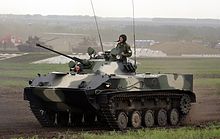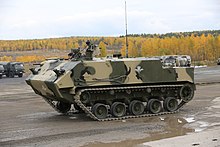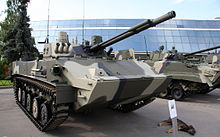BMD (tank)
| BMD | |
|---|---|

from left to right: BMD-3, BMD-2 and BMD-1 (2006) |
|
| General properties | |
| crew | 2 (commander, driver) + 5 airborne soldiers |
| length | 5.40 m |
| width | 2.63 m |
| height | 1.65–1.97 m hydraulically adjustable |
| Dimensions | 7.5 tons |
| Armor and armament | |
| Armor | 23 mm |
| Main armament | 73mm cannon 2A28 |
| Secondary armament | 7.62 mm MGP PKT PALR 9M14M "Maljutka" 2 × 7.62 mm course MG PKT |
| agility | |
| drive | Diesel engine type 5D20, 6 cylinder, 4-stroke 240 HP (177 kW) |
| suspension | Torsion bar |
| Top speed | 60-70 km / h |
| Power / weight | 23.5 kW / t |
| Range | 320-500 km |
The BMD is an airborne tank of the Soviet / Russian airborne troops . BMD is the translation of the Russian acronym БМД, which stands for Боевая Машина Десанта (Bojewaja Maschina Dessanta), which means something like "combat vehicle of the airborne troops".
history
In the Soviet Union, the possibilities of the parachute force were recognized very early. As vanguard units and quickly deployable reaction forces, paratroopers have been very successful since World War II . The lack of heavy weapons in combat was always a disadvantage. The Soviet military tried to solve this recognized problem very quickly. The first approaches were the ASU-57 self-propelled gun and its successor ASU-85 . However, lightly armored vehicles were required for troop transport and fire support. The result was the development and series production of the vehicles of the BMD family.
Models
BMD-1 (object 915)

The combat vehicle of the airborne troops BMD-1 "Object 915" was developed in 1965 in the design office of the Volgograd tractor factory and in 1966 went through the factory tests. In accordance with its intended use, its construction was subject to strict specifications in terms of dimensions and weight. Its armor is made of an aluminum alloy that only offers protection from fragments and fire from handguns. The chassis and drive are new designs. The BMD has five rollers and two support rollers on each side. The ground pressure of the vehicle is 0.5 kg / cm² and corresponds roughly to that of a soldier with marching gear, so that the BMD-1 can follow the foot troops even in difficult terrain. The ground clearance of the vehicle and the tension of the chains can be hydraulically regulated by the driver. This fact increases the cross-country mobility in some cases. The tank is buoyant.
The vehicle is powered by the water-cooled six-cylinder four-stroke diesel engine 5D-20 with an output of 176.6 kW (240 hp). The BMD-1 has good maneuverability and mobility and reaches a top speed of 70 km / h on the road and 9-10 km / h in water. The maximum range of the vehicle (on the road) is almost 500 km on one tank of fuel. The crew consists of seven men: commander, gunner, driver and four airborne soldiers (one to the right of the driver, three in the space behind the tower).
The tower was taken over by the BMP-1 . Just like this one, the BMD has the 73mm 2A28 cannon. As with the BMP, a launching rail for anti-tank guided missiles ( 9M14M "Maljutka" ) is mounted above the cannon barrel .
The 9K111 guided weapon complex, which can be used to fire the 9K111 Fagot or 9K113 Konkurs , can be mounted on the tower roof of the BMD-1P, which was produced from 1977 to 1985 .
In the bow of the hull there is a 7.62 mm machine gun mounted on the right and left.
With its weight of 6.7 t and its small dimensions, the BMD-1 can be transported by air and can be set down from aircraft at a height of 500 to 1500 m using parachute systems. In the first few years the BMD-1 was loaded onto platform P-7 together with a multi-dome parachute system (e.g. PRSM-915). The later reactive parachute system PBS-915 did not require a special platform.
Three BMD- 1s can be deployed from an Ilyushin Il-76M . The tank can also be dropped off from Mil Mi-6 helicopters .
On January 5, 1973, an airborne tank (BMD-1) was dropped for the first time in the world with two crew members (Lieutenant Colonel L. I. Scherbakow and Major A. W. Margelow ) inside the vehicle. A BMD-1, which was attached to a P-7 platform together with a special KSD container, had already been dropped in May 1975. There were three airborne soldiers in the KSD container.
Some of the currently known variants (more than 15 modifications in total):
5-roller chassis
- BMD-1 object 915
- BMD-1K Object 915K, commander variant
- BMD-1R Object 915R “Siniza”, turretless command staff vehicle , battalion level
- BMD-1P Object 915P, modernized BMD-1
- BMD-1M Object 915M, retrofitted to BMD-1P level during main repairs
- BMD-1PK Object 915PK, commander variant BMD-1P
6-roller chassis
- BTR-D Object 916, armored transporter
- BTR-RD "Robot", tank destroyer with anti-tank missiles
- BTR-ZD, air defense vehicle
- BREM-D Objekt 932, recovery vehicle
- BMD-1KSchM Object 926 "Soroka" (also BTRD-KSchM), command staff vehicle, division level
- 1W119 "Reostat", artillery reconnaissance vehicle
- 2S9 Object 925S "Nona-S" SFL, with 120 mm multi-purpose gun (gun / grenade launcher)
BMD-2 (Object 916) "Budka"
In 1984, the Volgograd tractor plant began series production of the "Object 916", which was added to the armament in 1985 as the BMD-2. The tub and drive remained almost unchanged. The BMD-2 was equipped with a newly developed turret in which the 30-mm automatic cannon 2A42 and the coaxial 7.62-mm MG PKT are housed in a weapon system stabilized in two levels. He also has the PALR complex 9K111, with which the PALR 9M111 (9M111-2) "bassoon" or 9M113 "bankruptcy" can be fired. For this purpose, the 9P135M launch system is installed on the tower roof. For assembly and operation, the shooter has to lean out of the tower hatch and is unprotected (as with the TOW weasel or marten ).
The two Bug-MG PKT were retained in the first production series. Only in the commander variant BMD-2K and in the later series the left MG was left out and the opening in the bow closed. The BMD-2K "Object 916K" was equipped with two R-173 radios, an AB-0.5-P / 30 generator, the GPK-59 course indicator, the GO-27 ABC reconnaissance device and two tables.
The multi-dome parachute systems with platform P-7, PRSM-916 and PRSM-925 as well as the reactive parachute system PBS-916 were used for parachute drop.
BMD-3 (Object 950) "Bakhcha"
The BMD-3 "Object 950" represents the next generation of airborne tanks. It was added to the armament in 1990. The tub, running gear and hydromechanical drive are new designs. He is equipped with the weapon module "Bakhcha", in which a 30-mm automatic cannon 2A42 and a coaxial 7.62-mm MG PKT are housed.
The armament includes a PALR launch system with PALR 9M113 "Konkurs" (on the tower roof), the 5.45 mm MG RPKS-74 (right) and an automatic grenade launcher AGS-17 Plamja (left).
The crew (two men + five airborne soldiers) are equipped with personal weapons. The 12.9 ton vehicle with its 2W-60-2 diesel engine develops a speed of 70 km / h with an output of 331 kW (450 PS) and a driving range of 500 km. In the water, the two waterjet drives bring the vehicle to 10 km / h.
The dimensions (6100 mm × 3114 mm × 2450 mm) allow transport by plane and dropping on the PBS-950 parachute system.
Further vehicles for the airborne troops were developed on the basis of the BMD-3: the SFL or tank destroyer 2S25 "Sprut-SD" with 125 mm gun 2A75, the transport vehicle BTR-DM (BTR-D3) and the ambulance vehicle BMM-D.
BTR-MD / M (Object 955) "Rakuschka"
The BTR-MD should take over the tasks of the outdated BTR-D and should accordingly replace the BTR-D and its modifications in the future. Its dimensions allow the tank to be transported by plane. Furthermore, the tank manages to overcome water hazards. The weight is about 13.2 tons. The crew consists of 2 men plus 13 airborne soldiers. The dimensions; Length 6085 mm, width 3150 mm, height 2700 mm. The armament consists of 2 7.62-mm-MGs PKTM. The engine output is 450 hp, which enables a speed of about 71 km / h on the road, about 45-50 km / h in the field and about 10 km / h in the water. The range on the road is about 500 km and off-road about 350 km. The climbing ability is 35 degrees. A hurdle of 0.8 m height can be overcome. The type of suspension is hydropneumatic. The armor is made of welded armor steel. The crew and airborne soldiers are located in the front and middle levels of the vehicle, while the engine components are located in the rear compartment.
BMD-4 (Object 960) "Bakhcha-U"
For several years several prototypes of a further development called BMD-3M "Bakhcha-U" have been shown. The new vehicle, which was probably taken over into the armament of the Russian armed forces as BMD-4 "Bakhcha-U" in 2008, can be recognized by the new weapon module "Bakhcha-U". The armament consists of the 100 mm 2A70 cannon coupled with the 30 mm 2A42 automatic cannon and a 7.62 mm MG PKT. Gun-launchable guided missiles 9K116-3 Basnya can be launched from the 2A70 cannon . The same bow armament as the BMD-3 (MG + grenade launcher) is specified as further armament. However, different variants can be seen in photos: 1. Variant with one weapon bay each for MG and grenade launcher, 2. Variant with two weapon bay for MGs. 3rd variant with a machine gun bay on the right in the bow. A modern fire control system and thermal imaging devices are also part of the equipment and make the vehicle a light tank with high firepower. The additional equipment is bought with a renewed increase in weight to 13.2 tons.
Despite its increased weight, this vehicle can also be lowered using the PBS-950M parachute system, with the crew remaining in special seats in the vehicle.
At the beginning of 2008 the first BMD-4 vehicles were officially handed over to the 137th Regiment of the 106th Airborne Division. A little later it was announced that the improved version BMD-4M would be included in the armament.
BMD-4M (probably Object 960M) "Sadowniza"
In May 2008 the newest variant with the designation BMD-4M was officially presented. The new vehicle has a completely redesigned hull. The bow, side walls and stern have been changed. The drive was also changed and fitted with new rollers. In the bow there are two newly designed small MG bay windows, the upper edges of the side walls are almost completely straight, the exhaust opening has been moved from the rear to the right side wall. The armament with the weapon module "Bakhcha-U" has been taken over.
User states
Current users
-
 Angola - As of January 2018, an unknown number of BMD-3s are in service with the Forças Armadas Angolanas .
Angola - As of January 2018, an unknown number of BMD-3s are in service with the Forças Armadas Angolanas . -
 Armenia - As of January 2018, 5 BMD-1 are in service with the armed forces .
Armenia - As of January 2018, 5 BMD-1 are in service with the armed forces . -
 Azerbaijan - As of January 2018, there are 20 BMD-1 in service with the armed forces .
Azerbaijan - As of January 2018, there are 20 BMD-1 in service with the armed forces . -
 Moldova - As of January 2018, 44 BMD-1s are in service with the Army .
Moldova - As of January 2018, 44 BMD-1s are in service with the Army . -
 Russia - As of July 12, 2019 there are 100 BMD-1, 700 BTR-D, 100 BTR-RD, 150 BTR-ZD, 1000 BMD-2, at least 12 BTR-MD, 10 BMD-3, 30 BMD-4 , 84 BTR-MDM, and 247 BMD-4M. in service with the airborne troops .
Russia - As of July 12, 2019 there are 100 BMD-1, 700 BTR-D, 100 BTR-RD, 150 BTR-ZD, 1000 BMD-2, at least 12 BTR-MD, 10 BMD-3, 30 BMD-4 , 84 BTR-MDM, and 247 BMD-4M. in service with the airborne troops .
-
 Turkmenistan - As of January 2018, there are 8 BMD-1 in service with the armed forces .
Turkmenistan - As of January 2018, there are 8 BMD-1 in service with the armed forces . -
 Ukraine - As of January 2018, 15 BMD-1 and 15 BMD-2 are in service with the Army and 30 BMD-1 and 45 BMD-2 are in service with the airborne troops.
Ukraine - As of January 2018, 15 BMD-1 and 15 BMD-2 are in service with the Army and 30 BMD-1 and 45 BMD-2 are in service with the airborne troops. -
 Uzbekistan - As of January 2018, there are 120 BMD-1 and 9 BMD-2 in the service of the armed forces .
Uzbekistan - As of January 2018, there are 120 BMD-1 and 9 BMD-2 in the service of the armed forces .
Former users
-
 Soviet Union - All BMD tanks of the Soviet Army were distributed to the states mentioned above.
Soviet Union - All BMD tanks of the Soviet Army were distributed to the states mentioned above. -
 Belarus - No longer in use by the Army by January 2018 at the latest .
Belarus - No longer in use by the Army by January 2018 at the latest .
literature
- David Miller, Christopher F. Foss : Modern combat weapons . Stocker-Schmid, Dietikon 1998, ISBN 3-7276-7092-4 .
- Article series from Техника и Вооружение. 2007 to 2008.
Web links
- Video of the presentation of the BMD-4M in March 2008 (Russian) accessed on September 4, 2009
Individual evidence
- ^ Hero of the Russia. In: voiceofrussia.com. Voice of Russia, July 26, 2005, accessed on November 3, 2014 (article on Alexander Vasilyevich Margelov, who was named Hero of the Russian Federation for this).
- ↑ Tanks for the airborne troops based on the BMD-3 such as "Rakuschka" u. a. In: www.topwar.ru. Retrieved March 4, 2013 .
- ↑ BMD-4 Airborne Infantry Fighting Vehicle. Global Security.org
- ↑ a b c d e f g h i j k l m n The International Institute for Strategic Studies (IISS): The Military Balance 2018 . 1st edition. Routledge, London 2018, ISBN 978-1-85743-955-7 (English, January 2018).
- ↑ ВДВ приступили к испытаниям многоцелевых БТР "Ракушка". In: РИА Новости. ria.ru, June 10, 2014, accessed on March 15, 2019 (in Russian, including 12 BTR-MDs were handed over to the military by the end of 2014).
- ^ The International Institute for Strategic Studies (IISS): The Military Balance 2018 . 1st edition. Routledge, London 2018, ISBN 978-1-85743-955-7 , pp. 194 (English, January 2018, 76 BTR-MDM).
- ↑ Псковская дивизия ВДВ усилилась батальоном новейшей десантируемой бронетехники. In: Mill.Press - Bоенное. военное.рф, March 14, 2019, accessed on March 15, 2019 (in Russian, among other things, a further 8 BTR-MDMs were delivered).
- ↑ ВДВ России до конца года получат 62 БМД-4М и 22 БТР "Ракушка". In: РИА Новости. ria.ru, accessed on March 15, 2019 (Russian, datum = 2015-03-03, among other things, 62 BMD-4M were handed over to the military by the end of 2015).
- ↑ Сергей Ищенко: Танковая атака генерала Шаманова. In: СвободнаяПресса. svpressa.ru, May 17, 2016, accessed on March 15, 2019 (in Russian, among others, 144 BMD-4Ms were handed over to the military by the end of 2016).
- ↑ Любовь Попова: "Пропустил товарищей, а сам не выбрался из люка": в Псковской обларниби на ученика. In: МБХ медиа. mbk.today, October 5, 2018, accessed on March 15, 2019 (Russian, including 1 BMD-4M sank in the river).
- ↑ "Курганмашзавод" закрыл долги по поставке боевых машин десанта БМД-4М. In: Mill.Press Bоенное. военное.рф, July 12, 2019, accessed on July 12, 2019 (Russian, including a total of 42 BMD-4Ms were delivered in 2019 (up to July 12 of that year)).






